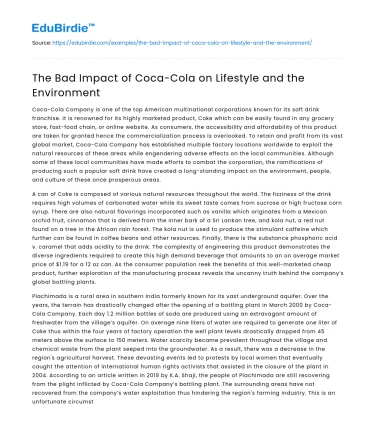Coca-Cola Company is one of the top American multinational corporations known for its soft drink franchise. It is renowned for its highly marketed product, Coke which can be easily found in any grocery store, fast-food chain, or online website. As consumers, the accessibility and affordability of this product are taken for granted hence the commercialization process is overlooked. To retain and profit from its vast global market, Coca-Cola Company has established multiple factory locations worldwide to exploit the natural resources of these areas while engendering adverse effects on the local communities. Although some of these local communities have made efforts to combat the corporation, the ramifications of producing such a popular soft drink have created a long-standing impact on the environment, people, and culture of these once prosperous areas.
A can of Coke is composed of various natural resources throughout the world. The fizziness of the drink requires high volumes of carbonated water while its sweet taste comes from sucrose or high fructose corn syrup. There are also natural flavorings incorporated such as vanilla which originates from a Mexican orchid fruit, cinnamon that is derived from the inner bark of a Sri Lankan tree, and kola nut, a red nut found on a tree in the African rain forest. The kola nut is used to produce the stimulant caffeine which further can be found in coffee beans and other resources. Finally, there is the substance phosphoric acid v. caramel that adds acidity to the drink. The complexity of engineering this product demonstrates the diverse ingredients required to create this high demand beverage that amounts to an on average market price of $1.19 for a 12 oz can. As the consumer population reek the benefits of this well-marketed cheap product, further exploration of the manufacturing process reveals the uncanny truth behind the company’s global bottling plants.
Save your time!
We can take care of your essay
- Proper editing and formatting
- Free revision, title page, and bibliography
- Flexible prices and money-back guarantee
Plachimada is a rural area in southern India formerly known for its vast underground aquifer. Over the years, the terrain has drastically changed after the opening of a bottling plant in March 2000 by Coca-Cola Company. Each day 1.2 million bottles of soda are produced using an extravagant amount of freshwater from the village’s aquifer. On average nine liters of water are required to generate one liter of Coke thus within the four years of factory operation the well plant levels drastically dropped from 45 meters above the surface to 150 meters. Water scarcity became prevalent throughout the village and chemical waste from the plant seeped into the groundwater. As a result, there was a decrease in the region's agricultural harvest. These devasting events led to protests by local women that eventually caught the attention of international human rights activists that assisted in the closure of the plant in 2004. According to an article written in 2019 by K.A. Shaji, the people of Plachimada are still recovering from the plight inflicted by Coca-Cola Company’s bottling plant. The surrounding areas have not recovered from the company’s water exploitation thus hindering the region's farming industry. This is an unfortunate circumstance as most of the villager’s occupation consists of agriculture and farm labor.
The presence of this company has not only affected Plachimada, but other cities such as San Cristobal de las Casa, Mexico where the manufacturing plant has influenced the people’s way of life, health, and cultural traditions. Like Plachimada, the citizens of San Cristobal de las Casa face water shortages even though it is well known for being one of Mexico’s rainiest regions. This limits the town’s access to heavily chlorinated running water to ever two days. As a result, residents are forced to buy water from tanker trucks or less expensive bottles of Coca-Cola. The easy accessibility of coke than water has led to an increase in diabetes and obesity to a point where diabetes is the second leading cause of death in the state. Lack of wastewater treatment to counteract the sewage runoff from the bottling plant has been another prevailing health issue for residents as the waterways have become a breeding ground for E. Coli and other infectious pathogens. Coca Cola has further integrated into the cultural traditions of San Cristobal de las Casa where cans of Coke are used in prayer rituals and people believe the drink has healing powers. This highlights how instrumental and deeply rooted the company is in shaping the conditions and culture of the community. Although the people of San Cristobal de las Casa suffer from this factory’s presence, it has been an essential source of income for the town as it contributes two million to the state’s economy and employs about 400 people. This compensation pales in comparison to the corporation’s profit of receiving 260 gallons of water per 10 cents. Such government exploitation, as well as inconsideration of the local people and environment, reflect the foundation of the Coca Cola industry.
The cost of producing a 12 oz can of Coke is more complex than what is perceived by the modern consumer. It is a product that intersects with the lives of people in each stage of the manufacturing process. For the residents of Plachimada and San Cristobal de las Casa, the globalization of Coca-Cola Company has brought devastating effects on the terrain, health, culture, and livelihood of these people. With the growing consumer population and lack of global awareness of these situations, Coca-Cola Company will continue benefiting from these unfortunate circumstances.






 Stuck on your essay?
Stuck on your essay?

